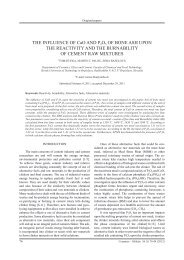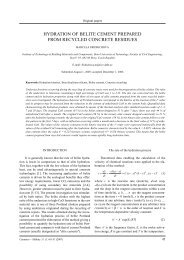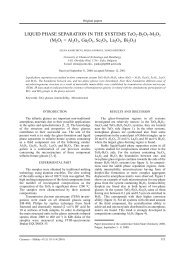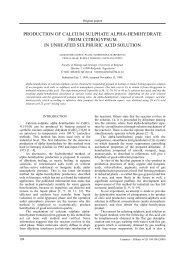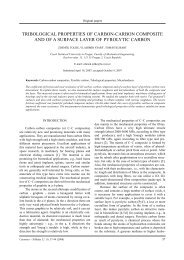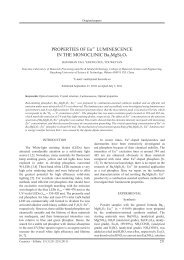Verification of the effect of concrete surface ... - Ceramics-Silikaty
Verification of the effect of concrete surface ... - Ceramics-Silikaty
Verification of the effect of concrete surface ... - Ceramics-Silikaty
You also want an ePaper? Increase the reach of your titles
YUMPU automatically turns print PDFs into web optimized ePapers that Google loves.
on <strong>the</strong> acrylic and tar-epoxy compositions. For example<br />
<strong>the</strong> Fosroc Limited company developed anti-carbonation<br />
paints <strong>of</strong> <strong>the</strong> elastomeric acrylic and acrylic-silane types.<br />
Two Czech companies, Spolek pro chemickou a hutní<br />
výrobu Ústí nad Labem and Panbex, produce a watertight<br />
tar-epoxy two-component compound. The disadvantage<br />
<strong>of</strong> <strong>the</strong>se systems is <strong>the</strong>ir low vapour permeability and <strong>the</strong><br />
resulting risk <strong>of</strong> damage to both <strong>the</strong> paint and <strong>the</strong> <strong>surface</strong><br />
layer <strong>of</strong> <strong>concrete</strong> in <strong>the</strong> spring months. At <strong>the</strong> Conference<br />
on Coating Compositions held in Pardubice, Czech<br />
Republic, in May 2000 [18], <strong>the</strong> development <strong>of</strong> a new<br />
two-component dispersion coating was presented, which<br />
became <strong>the</strong> subject <strong>of</strong> <strong>the</strong> applied research presented here.<br />
A similar coating was developed also by <strong>the</strong> chemical<br />
concern DOW Chemicals Ltd. (DOW XZ 92 533). This<br />
substance was not subjected to <strong>the</strong> test <strong>of</strong> protection<br />
against <strong>concrete</strong> carbonation by <strong>the</strong> manufacturer, but it<br />
was used as a reference in this research.<br />
CONCLUSIONS<br />
The results supplement a general picture <strong>of</strong> <strong>the</strong><br />
quality and usefulness <strong>of</strong> <strong>surface</strong> protection <strong>of</strong> mortars and<br />
<strong>concrete</strong>s against diffusion <strong>of</strong> atmospheric CO 2. Figure<br />
2 is a synoptic evaluation <strong>of</strong> <strong>the</strong> quality <strong>of</strong> protection <strong>of</strong><br />
cement mortar beams <strong>of</strong> 3 formulations by four types <strong>of</strong><br />
coating compositions A, B, C and D. The samples were<br />
placed for 12 months in an environment <strong>of</strong> concentrated<br />
98% CO 2. It is apparent that mortars and <strong>concrete</strong>s <strong>of</strong><br />
poorer quality (low strength, low compaction, excess <strong>of</strong><br />
gauging water) will be more susceptible to carbonation,<br />
and that protective coatings should mainly be applied<br />
to <strong>the</strong>se types <strong>of</strong> <strong>concrete</strong>s. Better quality <strong>concrete</strong>s are<br />
resistant to <strong>the</strong> diffusion <strong>of</strong> gaseous CO 2 <strong>the</strong>mselves to<br />
a certain extent (lower absorption capacity, porosity).<br />
A comparison <strong>of</strong> carbonation depths in both coated and<br />
uncoated samples <strong>of</strong> <strong>the</strong> best formulation (Formulation<br />
3 - compression strength 37 MPa) demonstrates however<br />
that <strong>surface</strong> coating with waterborne epoxy dispersions<br />
prevents even a minimum penetration <strong>of</strong> gaseous CO 2 into<br />
high-quality cement mortars, and its purpose is <strong>the</strong>refore<br />
not purely preventive. A big advantage <strong>of</strong> dispersion<br />
coatings is moreover <strong>the</strong> possibility <strong>of</strong> <strong>the</strong>ir application<br />
on wet <strong>surface</strong>s even at relatively low temperatures.<br />
Fur<strong>the</strong>r increase <strong>of</strong> <strong>effect</strong>iveness <strong>of</strong> coating systems<br />
in view <strong>of</strong> <strong>the</strong> permeability <strong>of</strong> acid gases can be achieved<br />
by an appropriate choice <strong>of</strong> aggregates with a barrier<br />
<strong>effect</strong>, and this is where fur<strong>the</strong>r research should be<br />
performed. It would also be beneficial to pay attention<br />
to <strong>the</strong> physical properties and mechanisms <strong>of</strong> composite<br />
action <strong>of</strong> <strong>the</strong> coating and various <strong>concrete</strong> <strong>surface</strong>s to<br />
eliminate <strong>the</strong> traditional defects <strong>of</strong> <strong>the</strong> coating systems,<br />
e.g. poor permeability and <strong>the</strong> resulting damage to <strong>the</strong><br />
coating-protected <strong>surface</strong> <strong>of</strong> <strong>the</strong> <strong>concrete</strong> structure due to<br />
<strong>the</strong> excess pressure <strong>of</strong> water vapour.<br />
Stehlík M., Novák J.<br />
Acknowledgement<br />
This work was supported by Research Project <strong>of</strong> <strong>the</strong><br />
Ministry <strong>of</strong> Education and Youth <strong>of</strong> <strong>the</strong> Czech Republic<br />
No. VVZ MSM 0021630511 „Progressive Building<br />
Materials with Utilization <strong>of</strong> Secondary Raw Materials<br />
and <strong>the</strong>ir Impact on Structures Durability“ and <strong>of</strong> <strong>the</strong><br />
Ministry <strong>of</strong> Industry and Trade <strong>of</strong> <strong>the</strong> Czech Republic No.<br />
MPO ČR. FT-TA3/056 „Waterborne epoxy dispersion <strong>of</strong><br />
new generation“.<br />
References<br />
1. Šmerda Z. et al.: Life <strong>of</strong> <strong>concrete</strong> structures, 1 st ed., p.89-<br />
170, ČKAIT, Praha 1999.<br />
2. Schulze W., Tischer W., Ettel W., Lach V.: Non-cement<br />
mortars and <strong>concrete</strong>s, 1 st ed., p.237-255, SNTL, Praha<br />
1990.<br />
3. Sebők T.: Additives and admixtures to mortars and <strong>concrete</strong>s,<br />
1 st ed., p.133-139, SNTL, Praha 1985.<br />
4. Matoušek M., Drochytka R.: Atmospheric corrosion <strong>of</strong><br />
<strong>concrete</strong>, 1 st ed., p.10-75, IKAS+ČKAIT, Praha 1998.<br />
5. Kovarčík I., Vávra Z.: Costruction & Interior, 15 (2009).<br />
6. Lőffelmannová I., Široká P.: Costruction & Interior, 22<br />
(2003).<br />
7. Bob C., Afana E. in: On-site assesment <strong>of</strong> <strong>concrete</strong><br />
carbonation, Proc. Inter. Confer. Failure <strong>of</strong> Concrete<br />
Structures, p. 84-87, Štrbské Pleso, Slovak Republic 1993<br />
8. Dhir R.K., Hewlett P.C., Chan Y.N.: Mag. Concr. Res. 148,<br />
137 (1989).<br />
9. Jungermann V.B.: Betonwerk Fertigteil Technik 6, 358<br />
(1982).<br />
10. Henning O., Lach V.: Chemistry in building industry,<br />
1 st ed., p.63-69, SNTL, Praha 1983.<br />
11. Diep S., Šlopková K.: Influence <strong>of</strong> <strong>concrete</strong> carbonation on<br />
<strong>the</strong> corrosion <strong>of</strong> ferro<strong>concrete</strong> elements, 1 st ed., p.36-56,<br />
TU Žilina, Žilina 2000.<br />
12. Pytlík P.: Concrete technology, 2 nd ed., p.304-310 a 366-<br />
371, VUTIUM, Brno 2000.<br />
13. Šauman Z.: Introduction to general physical chemistry<br />
and fundamentals <strong>of</strong> physical chemistry <strong>of</strong> silicates, 1 st ed.,<br />
p.140-159, SNTL, Praha 1965.<br />
14. Vavřín F., Retzl K.: Protection <strong>of</strong> building structures from<br />
corrosion, 1 st ed., p.11-130, SNTL, Praha 1987.<br />
15. Pichrt A.: Chemical revue, 10 (1986).<br />
16. Stehlík M. in: Principle <strong>of</strong> <strong>the</strong> accelerated carbonation<br />
depth test in 98% CO 2, p.115-117, Ed. Kořenská M.,<br />
Pazdera L., Academic Press Cerm s.r.o., Brno 2008.<br />
17. Houst Y.F., Wittmann F.H.: Depth pr<strong>of</strong>iles <strong>of</strong> carbonates<br />
formed during natural carbonation, Cem. Concr. Res. 32,<br />
1923-1930 (2002).<br />
18. Novák J. in: Concrete coatings, Proc. Inter. Confer. Conference<br />
on Coating Composition, p. 62-67, University <strong>of</strong><br />
Pardubice, Pardubice, Czech Republic 2000.<br />
84 <strong>Ceramics</strong> – Silikáty 55 (1) 79-84 (2011)



